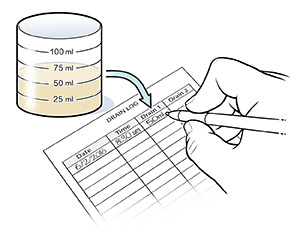Discharge Instructions: Caring for Your Jackson-Pratt Drainage Tube
Your health care provider discharged you with a Jackson-Pratt drainage tube. They commonly leave this drain within the abdomen and other cavities after surgery. It helps drain and collect blood and other body fluids after surgery. This can prevent swelling and potentially reduce the risk for infection. The tube is held in place by a stitch or two. It's covered with a bandage. Your provider will remove the drain when they determine you no longer need it.
Home care
-
Don’t sleep on the same side as the tube.
-
Secure the tube and bag inside your clothing with a safety pin. This helps keep the tube from being pulled out.
-
Empty your drain at least twice a day. Empty it more often if the drain is full. Wash and dry your hands before emptying the drain.
-
Lift the opening on the drain.
-
Drain the fluid into a measuring cup.
-
Record the amount of fluid each time you empty the drain. Include the date and time it was emptied. Share this information with your provider on your next visit.
-
Squeeze the bulb with your hands until you stop hearing air coming out of the bulb if your provider has instructed you to do so. (Sometimes the bulb is used as a reservoir without suction.) Check with your provider about specific drain instructions.
-
Close the opening.


-
If you are to change the dressing around the tube, follow the directions your provider has given you. Some dressings may not need to be changed, but your provider will let you know, so follow their specific instructions. Here are some general steps to follow:
-
Wash your hands.
-
Remove the old bandage.
-
Wash your hands again.
-
Gently clean the skin around the incision and tube site as instructed.
-
Put a new bandage on the incision and tube site. Make the bandage large enough to cover the whole incision area.
-
Tape the bandage in place.

-
Talk with your provider about showering with the drain. You may need to keep the bandage and tube site dry when you shower. Ask your health care team about the best way to do this.
-
“Stripping” the tube helps keep blood clots from blocking the tube. Ask your health care team how often you should strip the tube. Stripping may not be needed, depending on where and why your provider placed the tube. It may even be dangerous in some cases.
-
Hold the tubing firmly where it leaves the skin, with one hand. This keeps it from pulling on the skin.
-
Pinch the tubing with the thumb and first finger of your other hand.
-
Slowly and firmly pull your thumb and first finger down the tubing. You may find it helpful to hold an alcohol swab between your fingers and the tube to lubricate the tubing.
-
If the pulling hurts or feels like the tube is coming out of the skin, stop. Begin again more gently.
Follow-up care
Make a follow-up appointment as directed by your health care staff.
When to contact your doctor
Contact your provider or seek medical care right away if:
-
You have new or increased pain around the tube.
-
There is redness, swelling, or warmth around the incision or tube.
-
The drainage is foul-smelling.
-
You are vomiting.
-
You have a fever of 100.4°F ( 38°C) or higher, or as directed by your provider.
-
You have chills.
-
Fluid is leaking around the tube.
-
The incision doesn't seem to be healing.
-
Your stitches become loose or the drain starts to come out.
-
The tube falls out or breaks.
-
The drainage changes from light pink to dark red.
-
There are blood clots in the drainage bulb.
-
You have a sudden increase (over 30 mL) or decrease in the amount of drainage.
Online Medical Reviewer:
Jonas DeMuro MD
Online Medical Reviewer:
Raymond Turley Jr PA-C
Online Medical Reviewer:
Rita Sather RN
Date Last Reviewed:
2/1/2025
© 2000-2025 The StayWell Company, LLC. All rights reserved. This information is not intended as a substitute for professional medical care. Always follow your healthcare professional's instructions.